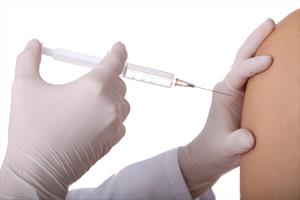Vaccine in human arm

Photo courtesy of Depositphotos
Since the recently reported case of rabies in a man from BC, Canada, I’ve done a lot of interviews. One thing that has struck me is the continued misconception about what rabies post-exposure prophylaxis (PEP) is, and the perception that it’s a long, painful ordeal.
It isn’t (at least not anymore)… and I know that from personal experience.
Rabies PEP is a set of injections given to someone who’s been exposed to rabies virus to prevent (prophylactically) the onset of disease. A long time ago, PEP involved enduring a large set of about 21 injections into the abdomen, which was quite unpleasant. Even though this is no longer the case, there’s an ongoing perception that rabies PEP is bad, painful or difficult (however, it is still very expensive).
So, what does current-day rabies PEP involve?
There are two approaches to PEP, depending on whether the person has been previously vaccinated (and has an adequate antibody titre) or not.
PEP for an unvaccinated individual:
- The first day (day 0), the person gets a dose of anti-rabies antibodies (also known as rabies immunoglobulin or RIG), and a rabies vaccine (so the body will make more of its own anti-rabies antibodies).
- The RIG is dosed based on the person’s weight. If there is a wound (e.g. bite) where the virus likely entered the body, as much of the RIG as possible is injected around the wound (this can be tricky when the wound is on a small part of the body, like a finger). The rest is given in a large muscle.
- Then the person get a rabies vaccine booster on days 3, 7 and 14.
PEP for a vaccinated individual:
- We have it easier. We just get two doses of vaccine on days 0 and 3 (in a large muscle, e.g. upper arm)
- No RIG is given, as it’s assumed a previously vaccinated person already has some anti-rabies antibodies and will respond to the first dose of vaccine very quickly because the immune system has already been primed.
- This is the same reason an exposed domestic animal should be vaccinated again as soon as possible, even if it’s vaccines are up-to-date. The goal is to activate the immune system again to help “intercept” any rabies virus in the body before it can cause infection of the central nervous system. The response is typically much better in a previously vaccinated animal, and there is no RIG that can be given to animals.
Does it hurt?
- A bit. It’s no different than any vaccine. I’d say my annual flu shot hurts at least as much as my rabies shots did.
Regardless, a rabies vaccine is a lot better to get than rabies. Anything we can do to encourage self-reporting of potential exposure, including making people aware that PEP isn’t a horrible ordeal, is important. That message hasn’t apparently gotten out well enough. However, avoiding exposure to the virus in the first place, by not handling wildlife and avoiding bites from domestic and wild animals alike, should always be the first line of defense. While PEP may not be as painful as it once was, it is still very expensive and there is a limited supply, so it should be saved for those who truly need it.
That personal experience?
Picture this. I’m driving home from the airport and get a call from my wife who’s locked in the bedroom with our kids because a bat is flying around the house. It’s not necessarily a big deal, except for the fact I thought I might have seen a bat in the house a couple days earlier, and a bat in a house with access to sleeping people = rabies exposure! I’ll save you the long but somewhat funny saga, and just say I eventually caught the bat. Our sigh of relief was short-lived, however, because it came back rabies positive. That meant we all needed rabies post-exposure prophylaxis (2 shots for Heather and I who have been vaccinated, but 6 shots for each of the kids). We also have a dog and cat, and they had to be considered exposed as well (the cat almost caught the bat). The cat, Finnegan, is an indoor cat but was vaccinated. The repercussions on the animals were much less than on us. However, if they had not been vaccinated, we would have had a problem.
Protocols for rabies exposure in non-vaccinated animals vary between jurisdictions, but long quarantines are the norm, and euthanasia often is chosen.
The take home message is, even with indoor-only animals….if you care about yourself, your family and your pets, vaccinate your pets against rabies. In most places it’s the law. It’s also good sense.
Reprinted with permission from Worms and Germs.